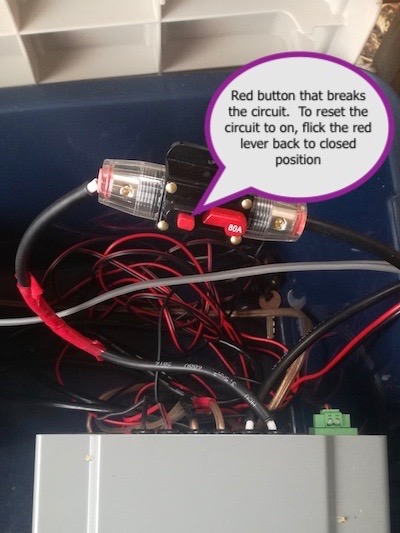
The cabin's electricity is powered by a solar panel connected to a 12v battery. There is a light for the deck and one for the interior. There is also a 300W inverter that provides regular 100v electricity for charging phones and running a fan.

Here we have the 12v battery and the charge controller connected to the solar panel. They are located in a cooler box on the cabin deck. From here, you can switch on and off the solar charging, and cabin power
 <
<
The charge controller is the grey box. Into it go three pairs of wires, each consisting of a negative and postive wire. One pair connects to the solar panel, one to the battery, and one to the 12v load (lights in cabin). Each pair has a circuit breaker on one of the wires. By flicking the toggle on the breaker the connection is set on or off. The sequence for turning on and off the breakers in important. Here it is: for turning on the solar panel charging: first load (lights), then battery and finally solar panel. For turning off, the reverse: first solar panel, then battery, then load. The important point is that the solar panel should never be sending current through to an unconnected load and battery - this can fry the charge controller. The cables going to the solar panel are thicker and black

A couple of the appliances are 'Chinese'- that is they were bought in China. Which means they run on a different voltage, 220v vs 100v of Japan. The three appliances running 'Chinese' are the chrome blue De'longhi espresso coffee machine, the brown coffee grinder, and the Philips blender. I have added a transformer - on the countertop - to provide the right voltage for these appliances. It is important that these two appliances are plugged into the transformer. It is very important that no other appliances should be connected to the transformer

Heating is provided by combo kerosene/electricity heaters. Cabin heating is provided by a kerosene heater. The picture shows the kerosene tank part of the heater Kerosene can be purchased at any filling station. There are red plastic canisters for that task. There is a battery powered pump to transfer the kerosene from canister to tank
>Link to recycling centre location. There is an option at the top for English translation of the page.
There is no garbage collection at the house. I dispose of the food waste in the woodland around the house and take everything else to the recycling centre. Rubbish is divided into following categories: metals, plastic bottles (PET), light bulbs, newspaper and cardboard, burnable rubbish and large items. For a regular trip (without large items) the cost is ¥100

There are a couple of electricity cables outside the house to be aware of if cutting grass, etc. One runs from the outside electrical outlet above the door to the deck, across the deck to the BBQ station. It provides decorative lights for the BBQ station. The other cables to be aware of run from the solar panel to the box containing the battery. They mostly run under the cabin but they do cross a stretch of grass behind the solar panel